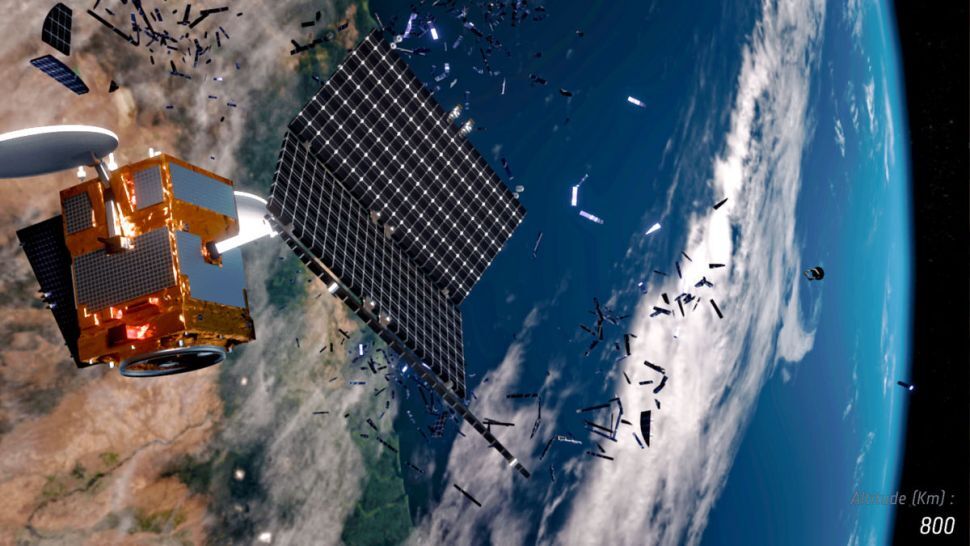9.02.2023
Kosmos 2499 broke apart in early January, according to the U.S. Space Force.

Artist's illustration of a satellite breakup in Earth orbit. (Image credit: ESA/ID&Sense/ONiRiXEL, CC BY-SA 3.0 IGO)
A mysterious Russian satellite broke apart early last month, creating a cloud of debris that could linger in Earth orbit for a while.
The Kosmos 2499 spacecraft disintegrated on the night of Jan. 3, according to the U.S. Space Force's 18th Space Defense Squadron (18th SDS), which tracks human-made objects in orbit.
The breakup event generated at least 85 pieces of trackable debris, 18th SDS said via Twitter on Monday(opens in new tab) (Feb. 6). That cloud of space junk is orbiting 726 miles (1,169 kilometers) above Earth — so high that it'll likely take a century or more(opens in new tab)for atmosphere drag to bring it down.
Getting space junk under control may require an attitude shift
The 18th SDS did not speculate about the cause of the breakup. And that's far from the only mystery surrounding Kosmos 2499.
The satellite launched to Earth orbit in May 2014 atop a Russian Rockot vehicle along with three Rodnik military communications satellites, according to RussianSpaceWeb.com's Anatoly Zak(opens in new tab).
Kosmos 2499 wasn't officially on the launch manifest; U.S. satellite trackers initially cataloged it as a piece of debris called Object E, Zak wrote. But then the "debris" began making maneuvers, apparently closing in on the Rockot's Briz-M upper stage.
"By the end of October [2014], the U.S. officially re-classified Object E as 'payload' instead of a 'fragment' and finally cataloged it as Kosmos 2499 (with a 'translated' spelling 'COSMOS 2499')," Zak wrote. "The U.S. military was now rechecking orbital parameters of the mysterious satellite three or four times a day!"
Analyses of orbital elements indicate that Kosmos 2499 got within just 0.47 miles (0.76 kilometers) of the Briz-M on Nov. 9, 2014, according to Zak. The spacecraft soon backed off but made an even closer approach on Nov. 25, coming within 0.33 miles (0.53 km) of the rocket body.
Such activities led to speculation that Kosmos 2499 and Kosmos 2491, a seemingly similar object that launched to Earth orbit in December 2013, were testing tech that could allow spacecraft to chase down and perhaps even disable other satellites. Indeed, Oleg Ostapenko, then the head of Russia's federal space agency Roscosmos, addressed such rumors at a press conference in December 2014.
"According to Ostapenko, the satellites were developed in cooperation between Roscosmos and the Russian Academy of Sciences and were used for peaceful purposes, including unspecified research by educational institutions," Zak wrote. "'They completed their mission,' Ostapenko said, without elaborating what that mission had been."
Despite Ostapenko's words, Kosmos 2499 remained active, off and on, for several more years. For example, the satellite — which ground observations suggest was less than 1 foot (0.3 meters) wide — conducted some maneuvers in early 2017, according to Zak.
But Kosmos 2499's maneuvering days are now done, as the satellite has given up the ghost. And its death has added yet more debris to an already cluttered environment.
According to the European Space Agency(opens in new tab), about 36,500 pieces of space junk at least 4 inches (10 centimeters) wide zoom around our planet. And those are just the objects big enough to be tracked; Earth orbit likely hosts more than 130 million objects at least 1 millimeter across.
Even the shards at the low end of that size spectrum can do damage to satellites and other spacecraft, considering how fast orbiting objects move. For example, the International Space Station, which orbits at an average altitude of roughly 250 miles (400 km), zooms around the planet at about 17,500 mph (28,000 kph).
Quelle: SC
